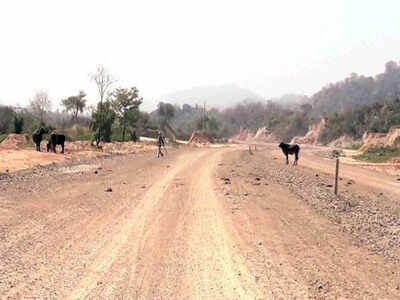
CHANDIGARH: People from at least 120 countries visited Sukhomajri village in Panchkula district in the 1980s and learnt skills in community management of forest and water from villagers, something which helped in the transition of the villagers from poverty to self-reliance.
Three dams were also created during that decade. But now, two of them have been destroyed for the Pinjore-Baddi 7.3-km long bypass project and water supply has been cut off for the third dam.
The ground water level also increased in the village due to construction of the dams. The village was named Sukhomajri for it being ‘sukha’ (dry and water deficient).
Water has now started receding in the village. The farmland has also shrunk and those that are left are turning dry and barren.
Only 14 hectares of the land is under farming in comparison to 51 hectares in 1999-2000.
The development has not only taken a toll on the dams, but six other villages, where the same project was replicated around the same time, have also been affected.
Madhu Sarin, social activist, who was selected to be a part of the water conservation through dam projects in Sukhomajri by Ford Foundation which funded the project in 1980s, reminisced the origin of the historic saga.
“In 70s, the Sukhna lake was full of silt. Approximately, 150 tonne per hecare silt would go into the lake, of which the Sukhna catchment in the Shivalk hills contributed 900 tonne per hectare silt. A team of the Central Soil and Water Conservation Research and Training Institute (CSWCRTI) along with officials from Punjab, Haryana and Chandigarh administrations walked the entire stretch from the lake to Sukhomjari village passing through the Sukhna catchment area. They found that run off of rain water from the denuded Shivalik hills of Sukhomajri was the actual cause of silt getting deposited in the lake. There were no trees to bind the soil and conserve the rain water,” she said.
She said an officer, who went beyond his official mandate to create the magic in Sukhomajri, the then head of CSWCRT in Chandigarh, P K Mishra, not only started vigorous plantation in the Shivalik hills to arrest soil erosion, but also tried to convince villagers to forsake cattle grazing in order to help recharge the Sukhna catchment area. However, villagers were incensed that for the sake of leisure of urban folk of Chandigarh, who came for picnic at the lake, officials were trying to wean away from the major livelihood option of the local people by stopping them to let their cattle graze. Other than this, they depended on rain-fed crops because agriculture was not thriving as well. Villagers were struggling with water scarcity. There was no way out that they could even have a hand pump due to dismal ground water level.
“Villagers were taught equitable sharing of benefits so that water from the dam was ensured for everyone, including landless farmers. Landless farmers were given liberty to give their water share to those with bigger landholding at mutually agreed price and earn income from that. People across caste lines, including the Dalits, were given their share in the village which was otherwise dominated by the Gujjars and the Jat communities,” she said.
“Former environment minister Maneka Gandhi too visited the village in the 1990 to see the exemplary work of the villagers in conserving the forest and water. While the then prime minister Indira Gandhi’s visit to the village was also scheduled, which was cancelled for some unknown reasons,” said Sarin.
However, Jeet Ram, a local villager, rued that all the three dams have come to naught due to the bypass project.
Vijay Bansal, head of the Shivalik Vikas Manch, advocated the bypass project saying: “There were more number of accidents as there was no direct link road from the Zirakpur-Kalka highway to reach Baddi for commuters and people ended up taking the Pinjore’s congested road. Locals have been protesting for this bypass which started two years ago and is slated to be completed this year and will give relief to commuters.”
Three dams were also created during that decade. But now, two of them have been destroyed for the Pinjore-Baddi 7.3-km long bypass project and water supply has been cut off for the third dam.
The ground water level also increased in the village due to construction of the dams. The village was named Sukhomajri for it being ‘sukha’ (dry and water deficient).
Water has now started receding in the village. The farmland has also shrunk and those that are left are turning dry and barren.
Only 14 hectares of the land is under farming in comparison to 51 hectares in 1999-2000.
The development has not only taken a toll on the dams, but six other villages, where the same project was replicated around the same time, have also been affected.
Madhu Sarin, social activist, who was selected to be a part of the water conservation through dam projects in Sukhomajri by Ford Foundation which funded the project in 1980s, reminisced the origin of the historic saga.
“In 70s, the Sukhna lake was full of silt. Approximately, 150 tonne per hecare silt would go into the lake, of which the Sukhna catchment in the Shivalk hills contributed 900 tonne per hectare silt. A team of the Central Soil and Water Conservation Research and Training Institute (CSWCRTI) along with officials from Punjab, Haryana and Chandigarh administrations walked the entire stretch from the lake to Sukhomjari village passing through the Sukhna catchment area. They found that run off of rain water from the denuded Shivalik hills of Sukhomajri was the actual cause of silt getting deposited in the lake. There were no trees to bind the soil and conserve the rain water,” she said.
She said an officer, who went beyond his official mandate to create the magic in Sukhomajri, the then head of CSWCRT in Chandigarh, P K Mishra, not only started vigorous plantation in the Shivalik hills to arrest soil erosion, but also tried to convince villagers to forsake cattle grazing in order to help recharge the Sukhna catchment area. However, villagers were incensed that for the sake of leisure of urban folk of Chandigarh, who came for picnic at the lake, officials were trying to wean away from the major livelihood option of the local people by stopping them to let their cattle graze. Other than this, they depended on rain-fed crops because agriculture was not thriving as well. Villagers were struggling with water scarcity. There was no way out that they could even have a hand pump due to dismal ground water level.
“Villagers were taught equitable sharing of benefits so that water from the dam was ensured for everyone, including landless farmers. Landless farmers were given liberty to give their water share to those with bigger landholding at mutually agreed price and earn income from that. People across caste lines, including the Dalits, were given their share in the village which was otherwise dominated by the Gujjars and the Jat communities,” she said.
“Former environment minister Maneka Gandhi too visited the village in the 1990 to see the exemplary work of the villagers in conserving the forest and water. While the then prime minister Indira Gandhi’s visit to the village was also scheduled, which was cancelled for some unknown reasons,” said Sarin.
However, Jeet Ram, a local villager, rued that all the three dams have come to naught due to the bypass project.
Vijay Bansal, head of the Shivalik Vikas Manch, advocated the bypass project saying: “There were more number of accidents as there was no direct link road from the Zirakpur-Kalka highway to reach Baddi for commuters and people ended up taking the Pinjore’s congested road. Locals have been protesting for this bypass which started two years ago and is slated to be completed this year and will give relief to commuters.”
World Cup 2019
Trending Topics
LATEST VIDEOS
More from TOI
Navbharat Times
Featured Today in Travel
Quick Links
Lok Sabha Election Schedule 2019Lok Sabha Election NewsDelhi Capitals teamMI team 2019Rajasthan Royals 2019RCB team 2019Maharashtra Lok Sabha ConstituenciesBJP Candidate ListBJP List 2019 TamilnaduShiv Sena List 2019AP BJP List 2019Mamata BanerjeeBJP List 2019 MaharashtraPriyanka GandhiBJP List 2019 KarnatakaAMMK Candidate List 2019BJP List 2019 WBLok Sabha Elections in Tamil NaduBSP List 2019 UPNews in TamilLok Sabha Poll 2019Satta Matka 2018PM ModiMahagathbandhanNagpur BJP Candidate ListChandrababu NaiduTamil Nadu ElectionsUrmila MatondkarNews in TeluguMadras High CourtTejashwi YadavArvind KejriwalTejasvi SuryaPawan KalyanArvind KejriwalYogi AdityanathJaya PradaSatta King 2019Srinagar encounter
Get the app









